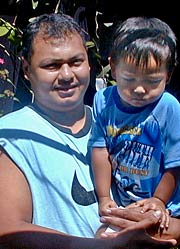Keaau is warned
of high arsenic
levels at gardens
The state is offering free tests
to gauge residents' exposure
State health officials have found high levels of arsenic in the soil at two community gardens in Keaau on the Big Island, and are offering free medical tests to residents to see if they have absorbed the potentially toxic element.
Arsenic meeting
What: The Department of Health will hold a public meeting to discuss its investigation of arsenic contamination of soils in the Keaau area.
When: 6-8 p.m. Tuesday Where: Keaau Community Center, 16-186 Pili Mua St. Who: Department of Health, Hazard Evaluation and Emergency Response Office
|
Arsenic at about four times the recommended limit was found in the soil at community gardens in two plantation communities known as 8 1/2 Mile Camp and 9 1/2 Mile Camp, according to Peard. There are fewer than 100 homes in the two camps altogether.
Long-term exposure to high levels of arsenic can lead to health problems including damage to the skin, heart, blood vessels and liver, as well as cancer. But without more data, it is not clear what risk residents are facing.
Residents who volunteer will provide urine samples for testing starting later this month. The Centers for Disease Control and Prevention is helping the state with the exposure investigation.
The state Department of Health has been testing for arsenic in the soil at various sites in Keaau, south of Hilo, and will hold a public meeting Tuesday at 6 p.m. at the Keaau Community Center to discuss the results. It sampled soil at parks, schools and undeveloped land near residential areas along with the community gardens.
Health officials alerted plantation camp residents in April when preliminary tests showed that the community gardens had the highest levels of arsenic of the sites tested. Staff met with residents to advise them on how to minimize exposure.
"Because of the levels in our analysis, we thought they needed to know right away," Peard said.
Young children, who tend to put their hands and toys into their mouths, are at higher risk of swallowing arsenic-laced soil, but adults can also ingest arsenic through traces of soil on their hands, cigarettes or vegetables.
The Health Department told residents to keep young children from playing in the gardens and to thoroughly scrub produce and pare root vegetables. It also advised gardeners to avoid putting fingers, tools or other items in their mouths and to wash all soil off hands and face, especially before eating or smoking.
Officials also plan to test vegetables raised in the gardens for arsenic, but Peard said incidental ingestion of soil is considered the likely route for arsenic exposure.
Herbicides containing arsenic were used for weed control on sugar cane production in the Hawaiian islands from about 1915 to 1950. Other potential sources include arsenic used as an insecticide in Canec wallboard and wood preservatives.
Arsenic levels of up to 22 parts per million are considered normal in Hawaiian soil. The samples at the community gardens were many times that, averaging from 300 to 370 parts per million, according to Peard.
Factoring in bioaccessibility -- how much of that arsenic would likely be released in the stomach -- the level drops to four times the recommended level, he said.
The Department of Health began its investigation last year after high levels of arsenic were found in the soil of a site proposed for a small hotel at Keaau, mauka of the shopping center. The hotel development is still being assessed, according to Bill Walter, president of W.H. Shipman Ltd., a major landowner in the Keaau area.
"We have made a point of working closely with the Department of Health," Walter said yesterday. "We want to do what makes the most sense from a community health standpoint."
Area has history
of herbicide hazards
Older residents recall
the effects of spraying
arsenic-based Kill-All
KEAAU, Hawaii » As a young man, Henry Texeira's fingernails and hair fell out, and his skin broke out in blisters when he sprayed an arsenic-based herbicide in sugar cane fields south of Hilo.
Every time, he bounced back. He'll be 94 next month.
![]()

![]()
Henry Texeira: His fingernails and hair fell out after he sprayed the cane fields
Another brand name for the stuff was Kill-All.
Texeira offers a dramatic link to the source of arsenic in Keaau soil. The state Department of Health said in 2003 that the probable source was herbicides sprayed on the local sugar plantation from 1915 to 1950.
Health Department arsenic monitor John Peard warned that the public should not confuse Texeira's high-dose symptoms with the current situation, at far lower levels.
Nevertheless, the chemical is probably all around Keaau, said Texeira's son-in-law Bud Herzog, 74. He has lived in Keaau for nearly 40 years.
"They all had gardens and they all brought poison home," Herzog said.
In the 1920s and '30s, Texeira sprayed Penite from 5-gallon backpacks for 11 years. Then he became supervisor of the poison crew.
![]()

![]()
Theo Luiz: The Keeau father now has his toddler son wear shoes outdoors
The community has remained calm now, Herzog said. The attitude is, "So what else is going to happen?" he said.
At 8 1/2-Mile Camp, on the edge of Keaau, Texeira's great-grandson James Arquitola said, "They've got to do something. Just don't touch the dirt anymore."
His father grows vegetables in a community garden despite traces of arsenic. "They taste good," Arquitola said.
Arquitola's neighbor Theo Luiz tries to keep his son Kaden, 2, out of the dirt. Instead of going barefoot, Kaden now wears shoes outdoors. When he comes indoors, he gets his hands washed.
"At first, reading all the letters (of notification from the Department of Health), it was scary," Luiz said. "But I guess nothing really happened, so (life) is about the same."
E-mail to City Desk
[News] [Business] [Features] [Sports] [Editorial] [Do It Electric!]
[Classified Ads] [Search] [Subscribe] [Info] [Letter to Editor]
[Feedback]

